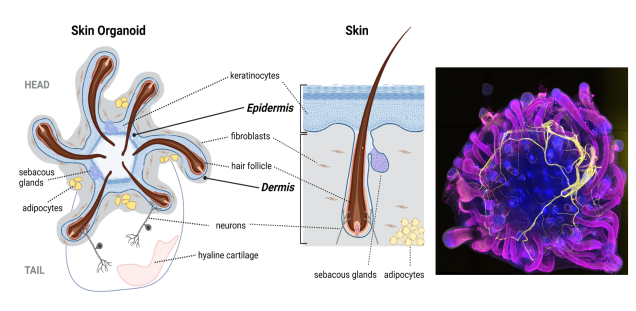
- Group leader
Junior group Herpesviruses and Organoids
Our research focuses on human herpesviruses and their analysis in complex in vitro systems. We aim to understand how different cell types within tissues respond to and cooperate during viral infections. Traditional in vitro models, such as monocultures and raft cultures, fail to replicate the intricate structural and functional features of human tissues. Moreover, many viruses exhibit strict host tropism, limiting the study of authentic viral infection, persistence, and pathogenesis in animal models.
To overcome these limitations, we leverage advanced organoid-based infection models. Our primary research focus is the skin — a key site for viral entry, pathogenesis, and long-term viral persistence. We generate highly complex skin organoids from human induced pluripotent stem cells (hiPSCs), which closely mimic human skin architecture. These organoids feature a stratified epidermis, a dermis, hair follicles, sebaceous glands, and an extensive innervation network.
Using these organoids, we study infections caused by skin-tropic DNA viruses, particularly herpes simplex virus 1 (HSV-1). Our research investigates which cell types are susceptible to infection, how the virus spreads within the tissue, and how the host tissue responds to infection. For these studies, we employ a range of advanced techniques, including immunohistochemistry, whole-mount staining, and transcriptomic analyses (bulk RNA-seq, single-cell RNA-seq, and spatial transcriptomics) to achieve a comprehensive spatial and temporal understanding of the infection process. In this project, we collaborate closely with the Leibniz Institute of Virology in Hamburg.
In addition to studying viral infections, we are actively working to further develop the skin organoid system to address its current limitations, such as the absence of vascularization and immune cells. In collaboration with DESY (Deutsches Elektronen-Synchrotron) and the Institute for Nanostructure and Solid State Physics of the University of Hamburg we integrate organoid-on-a-chip technology and 3D high-resolution X-ray imaging. Our goal is to create a vascularized, innervated, and immune-competent 3D skin-on-a-chip model that enables next-level research on human pathogenic skin viruses.
Staff • Group Czech-Sioli
- Medical-technical assistant
- Masterstudent
